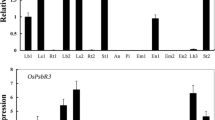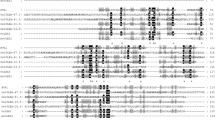Abstract
A novel OSPGYRP gene encoding a rice proline-, glycine- and tyrosine-rich protein was isolated from cold-stress treated rice seedlings using suppression subtractive hybridization. Both amino acid sequence analysis and subcellular localization confirm that OsPGYRP is a novel protein involved in vesicle trafficking. The expression of the OSPGYRP gene was induced by cold, salt, and osmotic stress. In addition, expression of the OSPGYRP gene in E. coli increased the resistance to cold stress. These results show that OsPGYRP is a novel protein involved in vesicle trafficking and plays an important role in plant adaptation to stress.




Similar content being viewed by others
References
Clemen CS, Herr C, Lie AA, Noegel AA, Schröder R (2001) Annexin VII: an astroglial protein exhibiting a Ca2+-dependent subcellular distribution. NeuroReport 12:1139–1144
Deretic D (2006) A role for rhodopsin in a signal transduction cascade that regulates membrane trafficking and photoreceptor polarity. Vision Res 46:4427–4433
Deretic D, Williams AH, Ransom N, Morel V, Hargrave PA, Arendt A (2005) Rhodopsin C terminus, the site of mutations causing retinal disease, regulates trafficking by binding to ADP-ribosylation factor 4 (ARF4). Proc Natl Acad Sci USA 102:3301–3306
Geelen D, Leyman B, Batoko H, Di Sansabastiano GP, Moore I, Blatt MR (2002) The abscisic acid-related SNARE homolog NtSyr1 contributes to secretion and growth: evidence from competition with its cytosolic domain. Plant Cell 14:387–406
Gerke V, Moss SE (2002) Annexins: from structure to function. Physiol Rev 82:331–371
Marty I, Monfort A, Stiefel V, Ludevid D, Delseny M, Puigdomenech P (1996) Molecular characterization of the gene coding for GPRP, a class of proteins rich in glycine and proline interacting with membranes in Arabidopsis thaliana. Plant Mol Biol 30:625–636
Matsushima N, Creutz CE, Kretsinger RH (1990) Novel secondary structures proposed for the tandem repeats within rhodopsin, synaptophysin, synexin, gliadin, RNA polymerase II, hordein, and gluten. Proteins 7:125–155
Mazel A, Leshem Y, Tiwari BS, Levine A (2004) Induction of salt and osmotic stress tolerance by overexpression of an intracellular vesicle trafficking protein AtRab7 (AtRabG3e). Plant Physiol 134:118–128
McBroom AJ, Kuehn MJ (2007) Release of outer membrane vesicles by Gram-negative bacteria is a novel envelope stress response. Mol Microbiol 63:545–558
Mortimer JC, Laohavisit A, Macpherson N, Webb A, Brownlee C, Battey NH, Davies JM (2008) Annexins: multifunctional components of growth and adaptation. J Exp Bot 59:533–544
Qi YH, Kawano N, Yamauchi Y, Ling JQ, Li DB, Tanaka K (2005) Identification and cloning of a submergence-induced gene OsGGT (glycogenin glucosyltransferase) from rice (Oryza sativa L.) by suppression subtractive hybridization. Planta 221:437–445
Sangiorgio L, Strumbo B, Tenchini ML, Malcovati M, Ronchi S, Simonic T (2004) A novel Chlamydomonas reinhardtii gene potentially encoding a proline-, glycine-, and tyrosine-rich protein (PGYRP). Plant Sci 167:519–526
Silvia NB, Claudia M, Amanda M, Ricardo MJ, Vanessa C, Rogério M, Gilberto SM (2005) Survey of glycine-rich proteins (GRPs) in the Eucalyptus expressed sequence tag database (ForEST). Genet Mol Biol 28:608–624
Toki S (1997) Rapid and efficient agrobacterium-mediated transformation in rice. Plant Mol Biol Rep 15:16–21
Zhang Y, Sederoff R, Allona I (2000) Differential expression of gene encoding cell wall proteins in vascular tissues from vertical and bent loblolly pine trees. Tree Physiol 20:450–457
Acknowledgements
This work was supported in part by the Hi-Tech Research and Development Program of China (Grant No. 2006AA10Z1F7), the State Key Basic Research and Development Plan of China (2007CB109005), the National Natural Science Foundation of China for Innovative Research Team (Grant No. 30521004) and the Key grant Project of the Chinese Ministry of Education (Grant No. 307018).
Author information
Authors and Affiliations
Corresponding author
Electronic supplementary material
Below is the link to the electronic supplementary material.
Rights and permissions
About this article
Cite this article
Li, H., Yang, J., Wang, Y. et al. Expression of a novel OSPGYRP (rice proline-, glycine- and tyrosine-rich protein) gene, which is involved in vesicle trafficking, enhanced cold tolerance in E. coli . Biotechnol Lett 31, 905–910 (2009). https://doi.org/10.1007/s10529-009-9935-2
Received:
Accepted:
Published:
Issue Date:
DOI: https://doi.org/10.1007/s10529-009-9935-2




